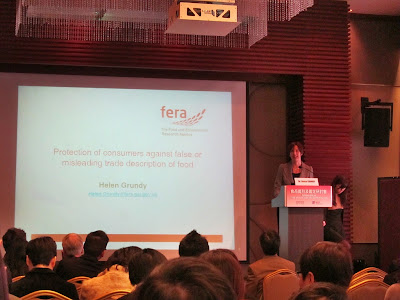Symposium on Food Identification and Authentication was organized by Hong Kong Council for Testing and Certification (HKCTC) and Hong Kong Accreditation Service on 17 Jan 2012. The symposium is focus on general issues about food adulteration and authentication, as well as technical aspects of food authentication. The contents were summarized below for sharing.
In the beginning, Prof. Kwan Hoi Shan (Centre Director of Food Research Center, CUHK and Chairman of the Accreditation Advisory Board, HKAS) gave a welcoming remarks. He said that Food is one of four selected trade to be focus for development.

Group Photo

Morning Session
The first speaker was Dr. Roger Wood (Chairman of Analytical Methods Committee of the Royal Society of Chemistry, UK) and his topic entitled "Interesting tension between economics (fraud/adulteration) and safety"

Dr. Wood said "Food Fraud is a current issue but an old problem; it is economically significant. Foodadditives were commonly used and in the 18th and early 19th centuries many of them were poisonous."

Then Dr. Wood briefed food crisis history in European Union. (See the following two diagrams)


Finally Dr. Wood concluded that adulteration was widespread often with large economic consequences. But analytical procedures required now were very sophisticated, but so is the adulteration. However, economic considerations were driving forces for those who adulterate foods - safety concerns were normally secondary.
The second speaker was Dr. Claude Guillou (EU Wine Stable Isotope Databank, European Commission Joint Research Center, Ispra, Italy) and his presentation named "The European Union Wine stable isotope databank".

World distribution of vine area was showed below and it was used Isotopic techniques for the control of wine in the European Union.

Without control the wine in the past caused methanol wine terrible disaster.

The measuremens of the ratios (X-heavy/X-common) provided information about the botanica animal or geographic origin of the products.

NMR spectrum of isotopic ratio (D/H) was demonstrated.

The environmental isotopes were absorbed by the vine and were found in the wine. If it was out of reference data, the wine was identified as a Fraudulence.

Dr. Claude Guillou introduced an official method adopted by international Organization in Vine and Wine multi-component and multi-isotopic analysis.

Dr. Helen Grundy (Food and Environment Research Agency, UK) was the third speaker and her presentation was "Protection of consumers against false or misleading trade description of food"

Fera is a science agency of a UK government department - Defra (Department for Environment, Food and Rural Affairs) and it provides high quality food and environment research to support other government depts, industry and EU.

Dr. Grundy briefed the definition of food adulteration and UK food fraud below:
Food adulteration definition - "... the process of extending or completely replacing a premium food product with cheaper ingredients for financial gain".
UK Food Fraud Definition - "... when food is deliberately placed on the market, for financial gain, with the intention of deceiving the consumer".
She introduced four techniques for identifying food adulteration
1) Authenticity by IRMS methods (Authenticating geographic origin)
2) Protein studies: Liquid Chromatography Mass Spectrometry
3) Metabolomics Applications - NMR
4) DNA techniques
"Proteomics: Determine species origin of gelatine" using second method was shown in following diagram.

"Identification and characterisation of antimicrobial components of Manuka honey" using NMR technique was demonstrated below.

Q&A Session

Prof. Kwan Hoi Shan was the fourth speaker and his topic was "DNA marker sequence database for authentication of dried seafood and tonic foodstuff in Hong Kong"

In the beginning, Prof. Kwan explained the role of a university to assist in the testing and certification industry.

He said the first stage development of platform for authentication of dried seafood and tonic food products were used Next Generation DNA Sequencing techniques to establish multiple DNA markers database, which targeted on 5 main dried seafood and tonic products included Fish Maw, Abalone, Dried Scallops, Sea cucumber and Bind's nest.

The simple workflow (in Chinese) was described.

BLAST result of DNA sequences for Abalone were showed.

Finally, Prof. Kwan demonstrated the sample DNA sequence database.

The fifth speaker was Mr. Tse Hon-ying (Customs & Excise Department, HKSAR Government) and his presentation entitled "Local legislation and enforcement situation for protection of consumers against false or misleading trade description in respect of foods sold in Hong Kong".

Mr. Tse introduced Trade Description Ordinance (TDO) Cap.362 in which aimed to prohibit false or misleading trade descriptions, false marks and mis-statements in respect of goods in the course of trade or business. There were 16 trade descriptions were under control in the following 3 diagrams.



Any person who commits an offence under the TDO is liable to a maximum fine of HK$500,000 and imprisonment for 5 years.
There were two enforcement works under TDO included Quick Response Team (QRT) and Product Monitoring Scheme (PMS). Then Mr. Tse said about testing involved in Food Identification and some cases sharing (e.g. Vegetables falsely represented as organic products and Fake Canned Abalone in Food Expo 2010)

The last speaker in the morning session was Mr. Ken Chung (General Manager, DCH Logistics Company Ltd.) and his presentation title was "Food safety visibility and traceability management application across the food supply chain".

Mr. Chung said Hong Kong food supply chain was not visiable and traceable. It needed to cross over each part in the food supply chain from the production original to customer.

He introduced one of his food supply chain management in red wine monitoring the temperature and humidity through RFID technology.

Then he proposed to establish establish a food safety public information platform between Mainland and Hong Kong.

Q&A Session

Reference:
HKCTC - http://www.hkctc.gov.hk/en/about.html
HKAS - http://www.itc.gov.hk/en/quality/hkas/about.htm
沒有留言:
發佈留言